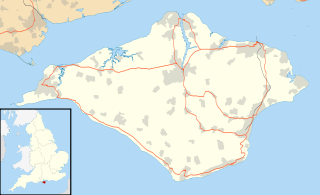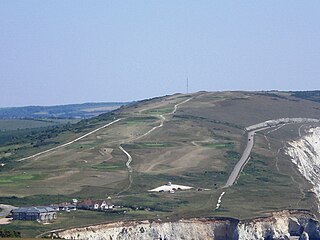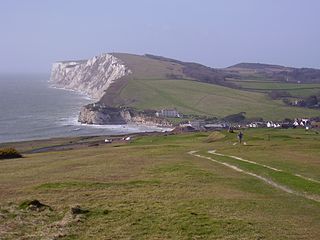
The Needles is a row of three distinctive stacks of chalk that rise about 30m out of the sea off the western extremity of the Isle of Wight, United Kingdom, close to Alum Bay, and part of Totland, the westernmost civil parish of the Isle of Wight. The Needles Lighthouse stands at the outer, western end of the formation. Built in 1859, it has been automated since 1994. The waters and adjoining seabed form part of the Needles Marine Conservation Zone and the Needles along with the shore and heath above are part of the Headon Warren and West High Down Site of Special Scientific Interest.

Shanklin is a popular seaside resort and civil parish on the Isle of Wight, England, located on Sandown Bay. Shanklin is the southernmost of three settlements which occupy the bay, and is close to Lake and Sandown. The sandy beach, its Old Village and a wooded ravine, Shanklin Chine, are its main attractions. The esplanade along the beach is occupied by hotels and restaurants for the most part, and is one of the most tourist-oriented parts of the town. The other is the Old Village, at the top of Shanklin Chine. Together with Lake and Sandown to the north, Shanklin forms a built up area of 21,374 inhabitants (2011).

The Needles Batteries are two military batteries built above the Needles stacks to guard the West end of the Solent. The field of fire was from approximately West South West clockwise to Northeast and they were designed to defend against enemy ships.

Brook is a village on the Isle of Wight, England. According to the Post Office the 2011 census population was included in the civil parish of Brighstone.

Compton Bay is a bay located on the southwest section of the Isle of Wight, England. Its north western edge is defined by the distinctive white chalk cliff of Freshwater Cliff, named after adjacent Freshwater Bay, which forms a small cove with the village of Freshwater situated just behind. Its north eastern edge is formed from the soft red and orange cretaceous rocks of Brook Bay, which are rapidly eroding.

Afton Down is a chalk down near the village of Freshwater on the Isle of Wight. Afton Down faces Compton Bay directly to the west, while Freshwater is approximately one mile north.

Tennyson Down is a hill at the west end of the Isle of Wight just south of Totland. Tennyson Down is a grassy, whale-backed ridge of chalk which rises to 482 ft/147m above sea level. Tennyson Down is named after the poet Lord Tennyson who lived at nearby Farringford House for nearly 40 years. The poet used to walk on the down almost every day, saying that the air was worth 'sixpence a pint'.

Walpen Chine is a geological feature on the south west coast of the Isle of Wight, England. It is west of the village of Chale. It is a sandy coastal ravine, one of a number of such chines on the island created by stream erosion of soft Cretaceous rocks. It leads from the 190 feet high clifftop next to the Isle of Wight coastal path to a knickpoint approximately halfway down the cliff face above Chale Bay beach.

Ladder Chine is a geological feature on the south west coast of the Isle of Wight, England. It is west of the village of Chale. It is a sandy coastal ravine, one of a number of such chines on the island created by stream erosion of soft Cretaceous rocks. It leads from the 190 foot high clifftop to a knickpoint approximately halfway down the cliff face above Chale Bay beach.

New Chine is a geological feature on the south west coast of the Isle of Wight, England. It is west of the village of Chale. It is a sandy coastal ravine, one of a number of such chines on the island created by stream erosion of soft Cretaceous rocks. It leads from the 190 foot high clifftop to a knickpoint approximately one third of way down the cliff face above Chale Bay beach.

Cowleaze Chine is a geological feature on the south west coast of the Isle of Wight, England. It lies to the west of the village of Little Atherfield.

Chale Bay is a bay on the south west coast of the Isle of Wight, England. It lies to the west of the village of Chale from which it takes its name. It faces south west towards the English Channel, its shoreline is 5km in length and is gently curving. It stretches from Artherfield Point in the north west to Rocken End in the south east.

Scratchell's Bay is a bay on the south west coast of the Isle of Wight, England just to the south east of The Needles. It faces roughly south towards the English Channel, it is 250m in length and is straight. The name is thought to have come from one of the many names for the Devil.

Totland Bay is a bay on the west coast of the Isle of Wight, England. It lies one-quarter of an mile (0.4 km) to the west of the village of Totland from which it takes its name. It faces north west and has a 2.5-mile-long (4.0 km) shoreline and is made up of a straight west facing coast which has a beach, concrete seawall, groynes and derelict 450-foot-long (140 m) Victorian pier and a straight north facing rocky coastline. It stretches from Warden Point in the north to Hatherwood Point in the south-west.

Horseshoe Bay is a small bay on the south-east coast of the Isle of Wight, England. It lies at the east end of the headland of Culver Down. It faces south-east towards the English Channel and its shoreline is approximately 100 yards (90 m) in length. It should not be confused with a similarly named Horseshoe Bay about 8 miles (13 km) southwest at Bonchurch.

Orchard Bay is a small bay with sand and shingle beach on the south-east coast of the Isle of Wight, England. It lies to the south-west of the Ventnor Botanic Garden and just along the coast west from Steephill Cove. It faces south towards the English Channel, its shoreline is 220 yards (200 m) in length - 65 yards (60 m) of which is beach.

Brighstone Bay is a bay on the south west coast of the Isle of Wight, England. It lies to the south and west of the village of Brighstone from which it takes its name. It faces south west towards the English Channel, its shoreline is 7 km in length and is gently curving. It stretches from Sudmoor Point in the north west to Artherfield Point in the south east.

Brook Bay is a bay on the south western coast of the Isle of Wight, England. It lies to the west of the village of Brook. It faces south west out into the English Channel. It stretches about 2km from Hanover Point in the east to Sudmoor Point to the west. Much of the surrounding land, including the hamlet of Brookgreen is owned by the National Trust.


















